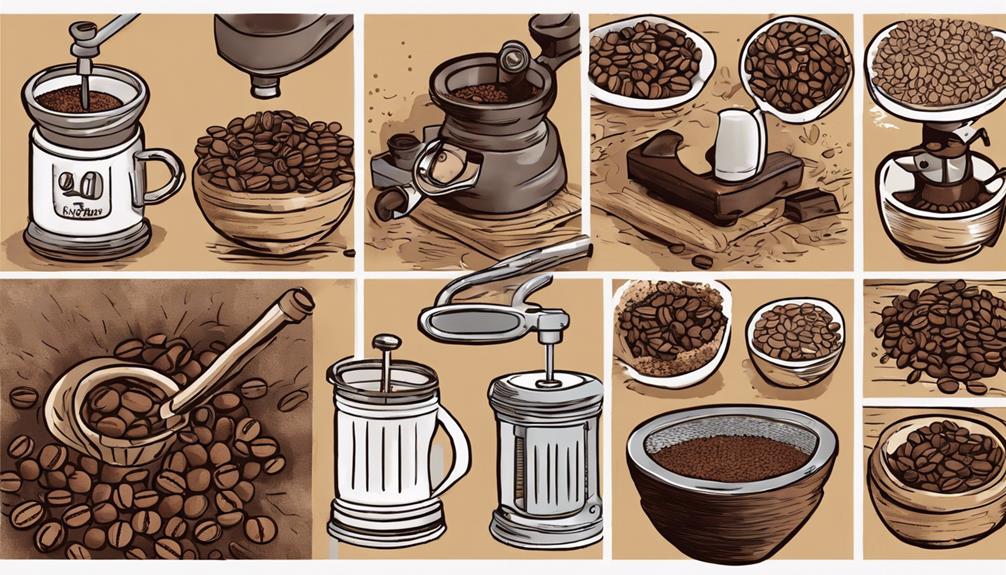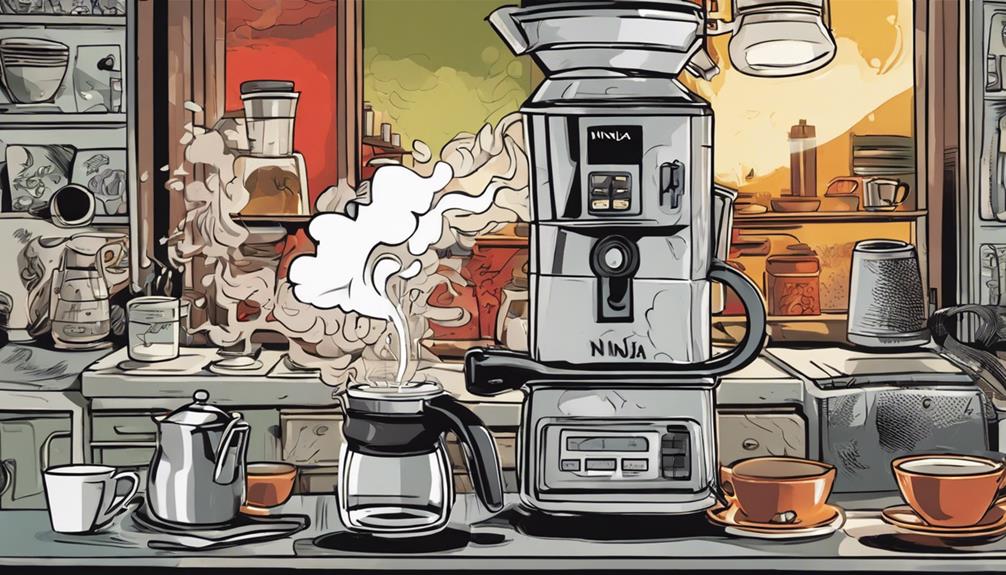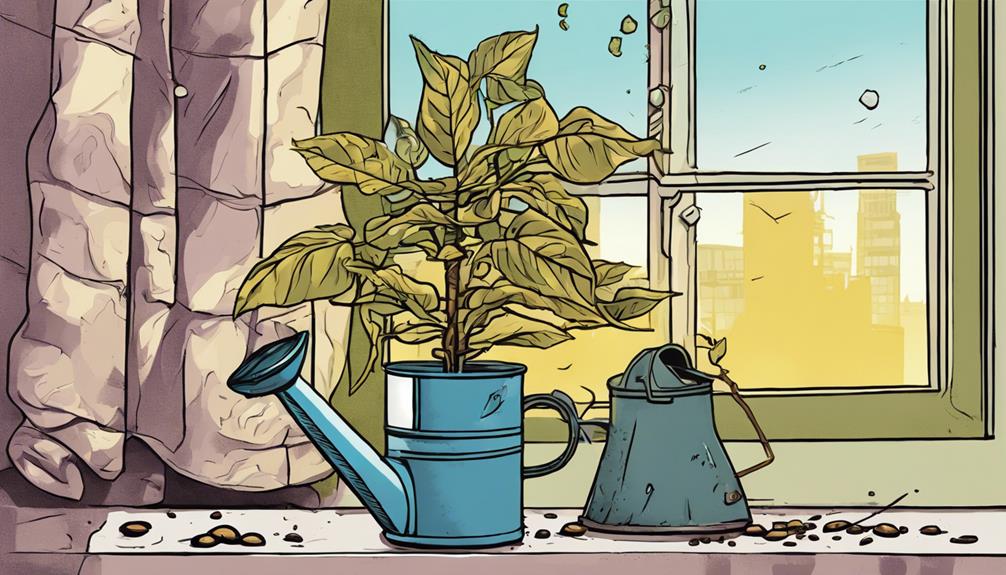Mix your coffee grounds to achieve the best flavor by combining complementary flavors. Try blending light and dark roasts to create a well-rounded profile and experiment with different origins for a unique tasting experience. It is important to be precise, so use a burr grinder to control the grind size and understand the different extraction stages. Adjust the ratios according to the coffee-to-water proportions. To achieve brewing perfection, use the right filter type and temperature. Water quality is crucial; aim for a temperature between 195-205°F for optimal extraction. Remember, even small adjustments can have a big impact on the flavor of your coffee. Enhance your coffee blending skills to enhance your tasting experience.
Key Takeaways
- Experiment with blending light and dark roasts for balanced flavors.
- Pair complementary flavors for a harmonious blend.
- Adjust ratios based on desired taste intensity.
- Use precise grind sizes for optimal extraction.
- Consider different origins for unique taste profiles.
Specialty Coffee Selection
When choosing specialty coffee, prioritize freshness and unique flavors to guarantee an exceptional coffee experience. Opt for freshly roasted whole beans to savor the full potential of specialty-grade coffee.
Specialty coffee undergoes rigorous grading by Quality Graders to guarantee it offers distinct and delightful flavors that set it apart from regular coffee varieties. Freshly roasted beans are a must-have as they preserve the intricate flavor profiles that make specialty coffee so special.
Additionally, whole beans maintain their freshness longer than pre-ground coffee, allowing you to enjoy a rich and flavorful cup every time. By choosing specialty-grade coffee that's freshly roasted and in its whole bean form, you're taking the first step towards indulging in a coffee experience that's 75% more enjoyable than non-specialty coffee.
Freshness and Storage Tips
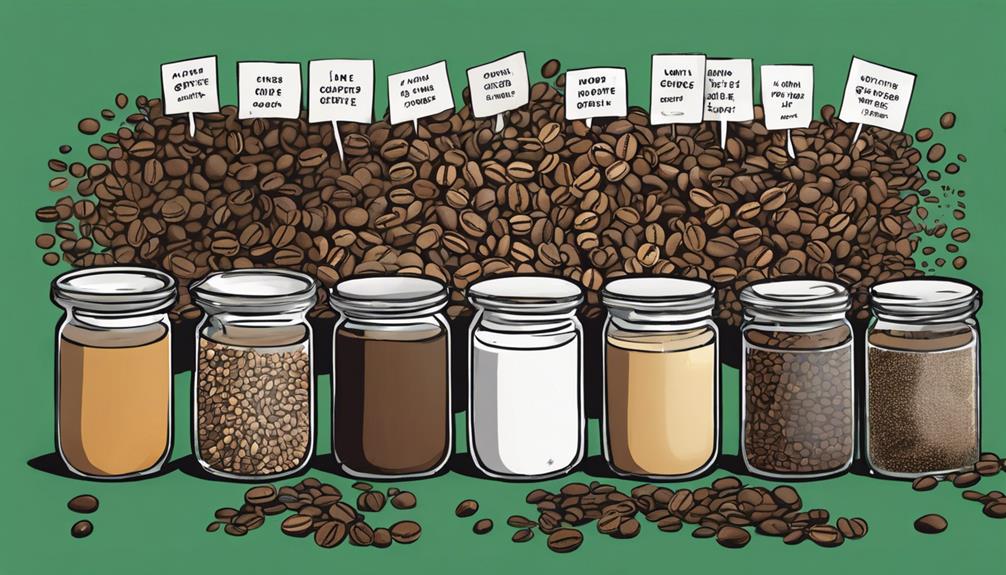
For best taste preservation, make sure your specialty coffee beans are stored in airtight containers away from heat, air, and light. Freshness is key when it comes to coffee, as specialty beans begin to lose their flavor compounds within 8 days of roasting. To maintain peak taste, grind size matters too. Grinding accelerates flavor loss, so it's best to grind your beans just before brewing for maximum freshness.
Consider these storage tips to preserve the quality of your coffee beans:
| Storage Tips | Description | Importance |
|---|---|---|
| Airtight Containers | Prevent exposure to air, heat, and light to maintain freshness. | High |
| Cool, Dark Place | Store in a cool, dark place away from direct sunlight. | Medium |
| Avoid Freezing | Freezing can impact the flavor and aroma of the coffee. | Low |
Blending Techniques for Flavors
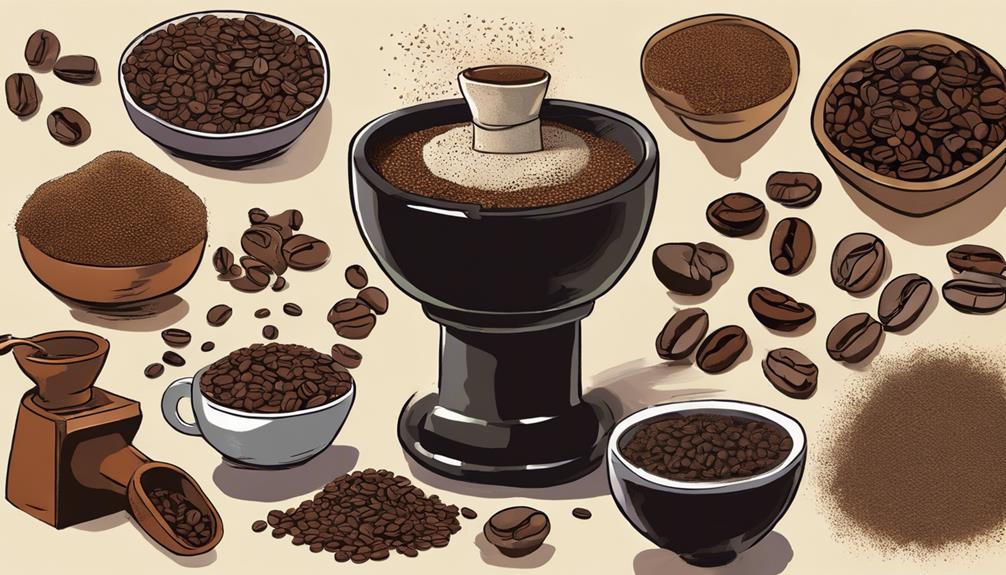
When it comes to blending techniques for flavors, you can elevate your coffee experience by experimenting with different combinations.
Try pairing flavors that complement each other to create a harmonious blend that tantalizes your taste buds.
Get creative with aromatic combinations to craft a unique and personalized coffee experience.
Flavor Pairing Tips
Experiment with blending different coffee grounds to craft complex and unique flavor profiles, combining beans with complementary taste notes like fruity and chocolatey.
To enhance your coffee blending skills, consider the following tips:
- Mix Light and Dark Roasts: Combine light and dark roast grounds to achieve a balanced flavor profile, adding complexity and depth to your brew. Light roasts bring brightness and acidity, while dark roasts contribute richness and boldness, resulting in a harmonious blend.
- Explore Different Origins: Experiment with blending coffee grounds from various regions to discover distinct flavor profiles. Each origin offers unique characteristics, allowing you to create a customized taste experience tailored to your preferences.
- Proper Ratio: Use a ratio of 70% base coffee and 30% accent coffee when blending for a well-rounded flavor. Adjust the proportions based on your desired flavor intensity, ensuring a harmonious combination of tastes in every cup.
Aromatic Blend Creations
To enhance your coffee blending skills and create captivating aromatic blend creations, consider incorporating various blending techniques for flavors. Blending different coffee beans allows you to enrich the complexity of flavors and aroma profiles in your cup.
Experiment with roast levels by combining light, medium, and dark roast grounds to achieve a balanced flavor profile that offers a range of taste experiences. Additionally, mixing beans from different origins with unique tasting notes can result in a well-rounded blend that entices your taste buds.
Adjusting the ratio of each ground type is key to customizing the taste and intensity of your coffee blend. By playing around with the proportions of each type of ground, you can fine-tune the flavor to suit your preferences perfectly.
Whether you prefer a bold and robust blend or a milder and more delicate one, the ability to adjust the ratio gives you the flexibility to create a blend that satisfies your coffee cravings. Experimenting with different combinations and ratios is the key to revealing the full potential of your aromatic blend creations.
Ratios and Recipe Adjustments

Understanding the importance of adjusting ratios and recipes based on coffee-to-water proportions is fundamental for achieving the perfect balance of strength and flavor in your brewed coffee.
Here are three key points to keep in mind:
- Brewing Process:
The brewing process heavily relies on the coffee-to-water proportions. Whether you prefer a stronger brew with a proportion of 1:15 or a milder taste with a proportion of 1:18, adjusting this proportion is vital for crafting your ideal cup.
- Small Adjustments:
Making small modifications in your ratios based on the amount of coffee used can make a significant difference in the taste of your coffee. These minor tweaks can help you fine-tune the strength and flavor to match your preferences.
- Recipe Maintenance:
Small Changes, Big Impact

For an excellent coffee brewing experience, consider how small adjustments can have a significant impact on the flavor of your coffee. Utilizing a burr grinder to precisely grind your coffee beans is a key step in adjusting your grind to perfection.
By understanding the 5 stages of extraction, you can stop the brewing process before bitter acids and tannins are released, ensuring best flavor extraction.
Tasting and recognizing the different extraction stages can guide you in making precise changes to your brewing process for a better coffee taste. Avoiding over-extraction by adjusting brewing variables like time and temperature can enhance the balance of acids, mellow flavors, and sugars in your coffee.
Precision Brewing With Scale

Using a scale when brewing coffee guarantees consistent quality by accurately measuring coffee-to-water proportions.
To make the most of precision brewing with a scale, remember these key points:
Accurate Proportions: Measuring coffee by weight ensures that you maintain the perfect balance of coffee grounds to water, leading to a more consistent and flavorful brew each time.
Bean Variability: Different coffee beans have varying densities, making it essential to measure by weight rather than volume. This precision allows you to adapt your brewing method to the specific characteristics of each type of coffee.
Enhanced Flavor Profiles: Achieving consistent brewing quality through precise measurements enhances the overall flavor of your coffee. By measuring your coffee by weight, you can optimize extraction and taste profiles, resulting in a more enjoyable coffee experience.
Coffee-to-Water Ratio Importance

Maintaining the correct coffee-to-water proportion is crucial for achieving the desired flavor richness in your brew. The standard ratio of 1:15 provides a robust, strong flavor, while a ratio of 1:18 yields a milder taste.
Different coffee types, such as House Blend or Single Origins, may require specific ratios for peak flavor extraction. Precision in measuring coffee by weight guarantees accuracy and consistency in brewing, ultimately leading to improved quality in your cup.
The coffee-to-water proportion directly impacts the taste profile of your coffee, influencing its strength and overall flavor richness. Experimenting with different ratios allows for customization of your coffee experience, highlighting unique flavor notes in each cup.
Grinding for Flavor Extraction

Grinding coffee beans enhances flavor extraction by increasing the surface area for the best extraction of flavor compounds.
To achieve a flavorful cup, follow these essential tips:
- Consistent Grind Size: Maintain uniformity in grind size to promote even extraction. This uniformity prevents the risk of over-extracted or under-extracted flavors, leading to a perfectly balanced brew.
- Adjusting Grind Coarseness: Experiment with different grind sizes to manipulate flavor profiles. Finer grinds intensify flavors, while coarser grinds offer a milder taste. Find the perfect balance to suit your preferences.
- Burr Grinders for Precision: Opt for burr grinders for accurate control over grind size. This control enhances flavor extraction, resulting in a more nuanced and balanced cup of coffee.
Water Quality and Temperature

You should pay close attention to the quality and temperature of the water you use for brewing your coffee. Filtering your water is essential to remove impurities and enhance the flavor extraction process.
Additionally, minerals in water play a pivotal role in creating a rich and balanced flavor profile in your coffee.
Filter Type Selection
Choosing the right filter type for your coffee brewing method is crucial, as it greatly influences the flavor and fragrance of your final cup. When selecting a filter, consider the following:
- Filter Type Matching: Align the filter type with your brewing method to achieve the desired flavor profile. Paper filters are ideal for a cleaner brew, while metal filters enhance body and flavor by allowing more oils to pass through. Cloth filters strike a balance, letting some oils through while retaining sediment for a well-rounded taste experience.
- Water Quality Impact: The quality of water used in brewing can affect how the filter performs. Impurities in water may alter the extraction process, leading to off-flavors in your coffee. Using filtered or bottled water can help maintain the integrity of the filter and improve the overall taste of your brew.
- Water Temperature Consideration: Water temperature plays a crucial role in filter effectiveness. Ensure the water is at the best temperature for brewing to extract the flavors properly. Too hot or too cold water can impact the extraction process and alter the taste of your coffee.
Brewing Temperature Importance
Aligning the water quality and temperature with your chosen filter type is crucial to maximizing flavor extraction and ensuring a balanced and enjoyable cup of coffee. When it comes to brewing temperature, maintaining it within the ideal range of 195-205°F is essential. This temperature spectrum allows for balanced extraction, promoting proper flavor development while avoiding bitterness.
Filtered water is highly recommended for brewing coffee as it enhances flavors and prevents unwanted tastes. It's best to steer clear of distilled water since it lacks the necessary minerals needed to extract flavors from the coffee grounds effectively. Consistency in water temperature is equally important; fluctuations can have a significant impact on the extraction process and alter the taste profile of your brew.
Water Quality Impact
Enhancing coffee flavor through filtered water and ideal brewing temperature is vital to achieving a delicious and well-balanced cup. The impact of water quality on your coffee experience can't be overstated. Here's why:
- Filtered Water: Using purified water removes impurities that can negatively affect the taste of your coffee. It provides a clean base for the flavors in the coffee grounds to shine through, resulting in a more enjoyable and nuanced cup.
- Water Temperature: Maintaining the correct water temperature, ideally between 195-205°F, is essential for proper extraction without scalding the coffee. This temperature range ensures that the flavors are extracted optimally, contributing to a well-rounded and flavorful brew.
- Mineral Content: Water quality, specifically the presence of minerals, greatly impacts the taste complexity and balance of your coffee. Minerals in the water can enhance the flavors of the coffee, leading to a more robust and satisfying drinking experience. Avoid using distilled water, as it lacks the necessary minerals for flavor development.
Brewing Consistency Techniques
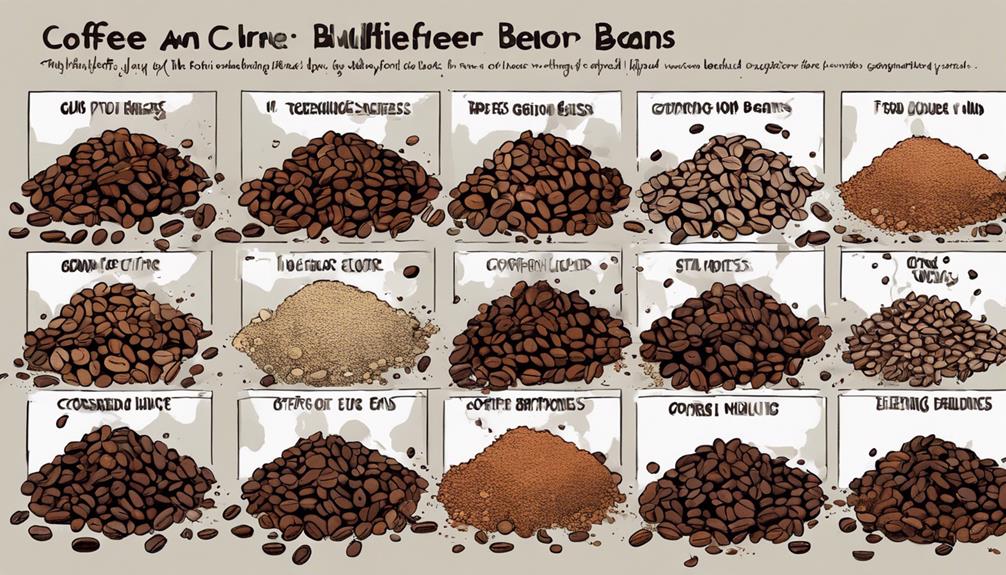
To achieve brewing consistency, focus on evenly distributing water over the coffee grounds for best extraction results. Consistent extraction is key to ensuring that all the coffee grounds are fully saturated, allowing for a uniform flavor profile.
Maintaining a proper water-to-coffee ratio is essential in achieving brewing quality. This ratio impacts the extraction process, influencing the strength and taste of the final brew.
To enhance brewing consistency, pay close attention to water contact time, as it greatly affects the overall flavor of the coffee. By ensuring that all grounds receive equal contact time with water, you can achieve a balanced and flavorful cup.
Improving brewing quality also involves keeping the water-to-coffee ratio consistent throughout the brewing process. This consistency helps in extracting the best flavors from the coffee grounds, bringing out the unique characteristics of the blend.
Frequently Asked Questions
How to Make Ground Coffee Taste Better?
To make ground coffee taste better, mix light, medium, and dark roast grounds for a balanced flavor. Add a touch of flavored coffee grounds for extra taste. Blend different origins to deepen richness. Adjust ratios to suit your preference for the perfect brew.
How Do You Get the Most Flavor Out of Ground Coffee?
To get the most flavor out of ground coffee, focus on blending different bean varieties. Aim for a 70% base coffee to 30% complementary coffee ratio. Consider roast levels for balance. Grind consistently and store well for freshness.
What Grind of Coffee Gives Best Flavor?
For the best flavor, stick to a medium grind size that balances extraction and taste. It hits the sweet spot, giving you a rich and flavorful cup of coffee. Experimenting with grind sizes can help you find your perfect brew.
How Do Coffee Shops Make Their Coffee Taste so Good?
To make their coffee taste delicious, coffee shops blend high-quality beans, roast them freshly, and adjust brewing methods for best flavors. Consistency in grinding and water quality are essential. Paying attention to detail in every step guarantees exceptional taste.
Conclusion
So, next time you're looking to brew the perfect cup of coffee, remember that blending coffee grounds is like creating a symphony of flavors in every sip. To achieve the perfect blend, consider experimenting with different ratios of coffee beans from various regions or of different roasts. This will allow you to discover a harmony of tastes that best suits your palate. Another factor to consider is the grind size of the coffee beans, which can greatly impact the flavor profile of the brew. If you’re unsure how to adjust hario coffee grinder for optimal results, consult the manufacturer’s instructions or seek guidance from a barista or coffee enthusiast.
Experiment with different ratios, grind sizes, and brewing techniques to find your perfect harmony.
With a little creativity and attention to detail, you'll be able to elevate your coffee experience to a whole new level.
Happy brewing!
